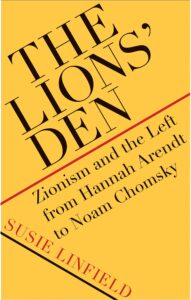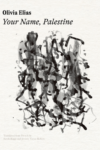
[Yale UP; 2019]
It is hard to actually elucidate a “Left-wing” position on any divisive political issue (or even a non-divisive one) because of the Left’s penchant for memory-holing its past anytime the present changes. A striking example: Zionism and, subsequently, Israel, which factions on the Left championed before deciding that Israel was a pariah state sitting outside the bounds of respectable governing. Israel certainly changed in that time: it was taken over by Likud and a Jewish fundamentalist nationalist strain bent on expanding borders and erasing non-Jews from the Eretz Yisrael. The cruel violence against the Palestinians in the years of illegal occupation and colonial expansion have turned Israel into an understandable enemy of Left-wing political movements. Since the post-Zionism and “New Historians” of the 1990s, the ethnic cleansing of the Palestinians from Israel’s founding became commonly known, and the Zionist fantasy dissolved from a story of “national liberation” to mourned tale of colonial conquest. But, as Susie Linfield writes in her new book The Lion’s Den: Zionism and the Left from Hannah Arendt to Noam Chomsky, it was not just Israel’s performance in the six-days war in 1967 and the social changes that happened later that inspired this shift.
It is the question of the Left’s changing relationship to Zionism that inspired Linfield’s book, meant to unpack the complicated relationship the Left has with Israel as a solution to the “Jewish question,” the unanswered query about what can be done about thousands of years of unquenchable antisemitism. The book is offered in a format that is somewhat familiar to academic publishing. In an effort to talk about the Left and Zionism she picks eight Left-wing authors to analyze: a few socialists, a few Europeans, a few Americans. The chapters then look at that author’s career and analyze their shifting descriptions of Zionism, how it evolved or lacked evolution, and what it said about the world around them. Linfield clearly finds the represented authors fascinating, and so offering a book on Zionism in the middle of a conflicted series of Israeli political scandals is a great way of trying to connect her own personal obsessions, which she indulges in writing the book, with a larger political issue. How she frames that issue is confused at times, it is based around her notions of what a “correct” position would be for the Left, one many anti-Zionists (but not all of Israel’s critics) she believes have abandoned. In doing so she claims to search for a Left universalism, but fails to show how that universalism would somehow immune Israel from the harsh denunciations it regularly receives from Left social movements.
The book is thus a complicated and well written polemic about the fractious way the Left has dealt with Israel. The hope for Linfield is that she will find an audience for such a narrow study by connecting it to the larger debates on Zionism (it worked on me, to a degree), but I do wonder if there is actually an audience enough for a book like this. All the represented authors besides Noam Chomsky and Hannah Arendt will be completely unknown to most readers. There are four socialists that Linfield acknowledges are basically nobodies outside of Europe, and then the people who are famous, like I.F. Stone, have been lost to the waves of time for most readers.
This leads to a second, and perhaps bigger problem with The Lion’s Den. Besides being a book that is ostensibly about the Left and Zionism, you learn very little about how the Left actually sees Zionism. Linfield’s argument, though somewhat muddled, is that the Left’s shift towards a focus on national liberation struggles and revolutions in the Global South pushed them away from support for Israel, which was denounced for its collaboration with imperialist powers. Since Palestine was a focus for many nations in the Arab world, as well as the Soviets, it served to reason that the Left would see it as an outpost of the empire in the Middle East (not an uncompelling argument). She says that the “hostility toward Zionism — the political self-determination of the Jewish people — became the Left’s ‘answer,’ albeit a contorted and dishonest one, to one of the Left’s fundamental postwar questions: How can we maintain our traditional universalist values in light of the nationalist movements sweeping the formerly colonized world?”
This seems simple enough, but as Linfield herself elucidates in the pages, it is much more complicated than that. There was an interplay between a systemically antisemitic Left and an Israel that embodies some of the worst qualities of statecraft and nationalism. She says the opposition to Israel allows the Left to maintain its anti-nationalism, though only in its most easily rejectable form, while essentially supporting the ultra-nationalism of everyone from the Palestinian Liberation Organization to Hamas to Hezbollah. There is a kernel of truth to this, where the Left’s lack of consistency on nationalism has led to a rightful critique about how Israeli crimes are singled out while other insurgent nationalisms are given a pass (though Israel having the right to bad behavior is a bad argument).
Each of the authors Linfield presents have their criticisms and kindnesses towards Israel, though these figures are more critical than they aren’t. She starts with Arendt, who she clearly admires and spends double the amount of time with than any other author. Arendt was an enthusiastic Zionist before abandoning the nationalist aspirations completely and becoming an aggressive opponent of Israel. Linfield traces this to Arendt’s obsessions with “Jewish shame,” the Diaspora of the underdog, and her impossible idealism.
The shame of the Jews, their collective humiliation, is a theme that traces through the book as it is a feature of almost all of the authors. The idea from many is that the Jewish Diaspora was infected with a pathology, and Zionism could either be a cure or a manifestation. For example, the second person discussed is Arthur Koestler, a fractious and neurotic man who hated Judaism so much he tried to erase his own Jewish ancestry from parts of his biography, and whose ideas were like a radicalized version of Israel Shahak. He thought that only through the laboring nature of Zionism could the Jews be cured of, well, being Jews. Besides Koestler, who was fairly called a Jewish antisemite, none of the other authors would accurately embody that label, but there was antisemitism, stereotypes, and anger towards Jewishness as a “wandering condition” present throughout. In drawing out this “Jewish shame,” Linfield demonstrates how post-war Jewish culture has been filled with mixed feelings, particularly in the largely secular Left culture of early Zionism. Antipathy is a part of this story.
Despite all of this, Linfield’s study suffers from the narrowness of its scope. The authors she studies are, largely, of the Old Left, so not representative of the shift Linfield hopes to analyze. Her allegations of an ideological split is in the area lingering around the six-day war (though not just derivative of it), and yet she focuses almost entirely on people whose careers were defined before it. Really only I.F. Stone and Noam Chomsky seem as though they can make up the latter discussion, but they are also on the oldest possible end of that spectrum. It would have made sense to actually look at Palestinian writers, as well as Leftist organizers, rather than just academics. The point here is that she locates a change and then shows almost no one that would be a part of the demographics of that change.
The absolute lack of a Palestinian perspective is glaring from the volume, where casually insulting characterizations of Arab politics are dotted throughout. It is also clear that a part of the shifting perspectives on Israel were not actually shifting, but because of the inclusion of more diverse voices, including from Palestinians and other people in the Global South. This is so obvious as to be absurd. Linfield is a progressive and there is some care taken here, but this gets to the fundamental position of the book: democratic universalism and internationalism should be the core feature of the Left, not supporting “underdog” coalitions who resort to terrorism, racism, and nationalism. This is a fair point, and one that challenges a lot of the political allegiances the Left has banked its vision of global revolution on since the 1960s. But in the single-minded focus Linfield applies, it also refuses to see value in the revolutionary movements that were key to throwing off colonialism and seeing through a freedom for identity. She sees complexity in Zionism, both good and bad impulses, but she understands that complexity as a response to the Jewish tragedy, particularly the Shoah. She should also see that complexity as valid in the Palestinian side, which she signals to but ultimately fails to really empathize with. This is particularly unforgivable at a time when Israel’s total annexation of the West Bank may be on the table, and after decades of war crimes against Palestinian civilians. It is also unclear why Linfield thinks that a more universalist Left would do anything other than continuing denouncing Israel for its real, not just contextually analyzed, crimes. A universalist Left she calls for may not forgive the national liberation movements it partners with for terrorism and bigotry, but it is doubtful it would find any more sympathy for the empire either.
She says the Palestinians are victims of “terrible leadership,” and places the blame for their situation on them as much as on Israel. This comes from the kind of cold, academic, and privileged position that Linfield is in, one where a white tenured professor living in New York can offer high-minded critiques of desperate political movements in the Global South. It is in this contradiction we find another issue with the selections: they are academics, not organizers. For Linfield, as for many in the academy, the term “Left” seems to be used to categorize the intelligentsia. But this says more about academics than it does the Left. The Left is the collective (though fractured) set of movements against oppression and inequality, which is made up of people organizing themselves to challenge power. Sure, there are researchers and professors who discuss these issues and contribute to them, but they don’t have their hands on the ploughshares. By focusing heavily on this elite caste of commentators as a representative portrait of the Left, Linfield shows that her vision of the Left is one characterized by these high-minded individuals, not the people on the ground doing the work and facing the consequences. Even if the sample was meant to be a good cross section of Left-wing discourse (though it is not), it would fail to actually discuss the Left as an amorphous phenomenon because it is using an extraordinary piece of it, not looking towards the rank-and-file. If Linfield wants to critique pro-Palestinian activism she would have to actually look at the world of organizing, not strongly worded op-eds, and that seems to be something she is totally ill equipped to do. This again reveals the dialectic at play here: Linfield is, herself, an academic at an elite university, and so it can be reasonably assumed that it is these sorts of figures that she sees as having outweighed significance. For Linfield, it is the leaders that matter, and so an entire political dimension can be analyzed primarily through the journalists and scholars rather than the “people’s history.”
All of this should not ignore that Linfield actually weaves the stories and analysis masterfully; the writing is clear, arguments clear, and it is an enjoyable read throughout. The main tragedy she sees in almost all of these authors is that they lack a realism to actually solve the Israel-Palestine conflict. She sees the One-State solution as an anachronism that cannot work in the modern real world, where either the Palestinians would dominate the Israelis, or the Israeli right would ethnically cleanse the Palestinians. Her solution is ardent two-statism, and in each chapter she points out where she thinks the authors she analyzes have failed to live realistically and provide real solutions.
The lack of pragmatism is a fair criticism, but it is one that Linfield herself shares. As people like Peter Beinart have pointed out recently, the two-state solution has been slowly creeping out of grasp as Israel expands settlements into what it has labeled as Judea and Samaria (or what the rest of the world calls the West Bank). This has carved up the future Palestinian state into swiss cheese, making its viability almost impossible. Linfield offers up an analysis that says that because the populations of the settlements are rather small in comparison to the neighboring Palestinians, it should be somewhat easy to build a Palestinian state. This ignores the actual political dimensions of the far-right in Israel, the role that fundamentalism now plays in Israeli identity, and how to actually deal with these settlements’ infrastructure. Instead, the One-State solution, as complicated as it is, may end up as the realistic one.
The final chapter is on Noam Chomsky, who she considers entirely “fraudulent.” She goes through, at painful length, different areas where she thinks Chomsky misunderstood or misrepresented the PLO, particularly around one particular 1976 UN resolution, and because of this lives in “Chomskyland” made up of self-citation and wishful thinking. Chomsky’s idea of the “no state solution” is particularly denigrated, though out of all the versions of reconciliation mentioned in the book, it now appears as possibly the only one that has some promise in its utopianism. Chomsky, for his part, has said that Linfield’s book was an “extraordinary collection of lies and deceit,” though Chomsky is not unknown for oversimplifying complicated issues and is not exactly regarded as the top level historian of the region.
Linfield’s discussion will surprise most readers with the amount of complexity it draws out of each author, using them as a starting point to discuss a conflict that, she rightly offers, there are no perfect answers for. Linfield has a point throughout: that the Left lacks a universalism when it comes to Israel, and that is not just in its response to Israel’s many real crimes. It is not clear what the universalism she thinks the Left should adhere to, perhaps a universal anti-nationalism or denunciation of human rights violations. Her issue, and much of the small pro-Israel Left, is that anti-imperialism has created a devil’s bargain, where despotic regimes become a friend and their narratives about Jews are allowed to persist. The problem here is that whether or not there are shifting standards when it comes to Israel, the state fails to meet any progressive standard both historically and contemporarily. There does not seem to be a situation when Israel, both historically through its ethnic cleansing or today in its oppressive occupation, could be accepted by a modern Left. The flaws of the book are obvious, but it is actually Linfield’s adept skills at writing it that overcome part of its limitations. I couldn’t help but think Linfield writing a book that actually looked at a broad section of Left opinion would have been much more illuminating, but that is, alas, not the book she wanted to write.
It would be easy to just diminish The Lion’s Den given its political problems, but in an issue like this there is no commentary free of political problems. There is a call here to see Zionism with a bit of nuance and complexity, though Linfield let’s it off the hook when the reality of Israeli oppression needs to be acknowledged, understood, and addressed. And in any story of Israel there needs to be the voices of Palestinians and the country’s many victims. Without that, it simply lacks the nuance it demands from others. It is doubtful that the book will change any minds (it even hardened my own against the viability of the two-state solution Linfield argues for), but a difference of opinion may be less important in this situation than the ability to see three dimensions.
Shane Burley is the author of Fascism Today: What It Is and How to End
It (AK Press, 2017). His work has appeared in Jacobin, Salon, Truthout, In These Times, Waging Nonviolence, ThinkProgress, Political Research Associates, Alternet, and Roar Magazine.
This post may contain affiliate links.







